THE HOUSEWARMING ONE
A hopeful, heartfelt menu for new beginnings in a new home.
MENU TO SERVE 6 PEOPLE
TWO VERY GOOD TOASTS - COURGETTE AND HALLOUMI, AND SHALLOT, CHEDDAR AND CHILLI
SLOW ROAST PORK WITH ASPARAGUS AND ANCHOÏADE
SAFFRON POTATOES
QUEEN OF PUDDINGS
We’ve bought a house. A grown up house, but also a house to grow into. My partner Tom and I have moved to South East London into a 3 bed with a garden, a bright kitchen and a lot of charm (although it is a bit cold). We are now 3 weeks in and I feel so thrilled to be here. As is always the case with a new home, there are lots of changes we want to make, as much as lots of new luxuries that we can’t get enough of. I have never, in the whole 10 years I have lived in London, had a gas hob until now. I know it’s not very eco of me to be excited about this but I literally am obsessed with it. I cannot wait to burn 10,000 aubergines and peppers on the open flames and finally make a good stir fry.
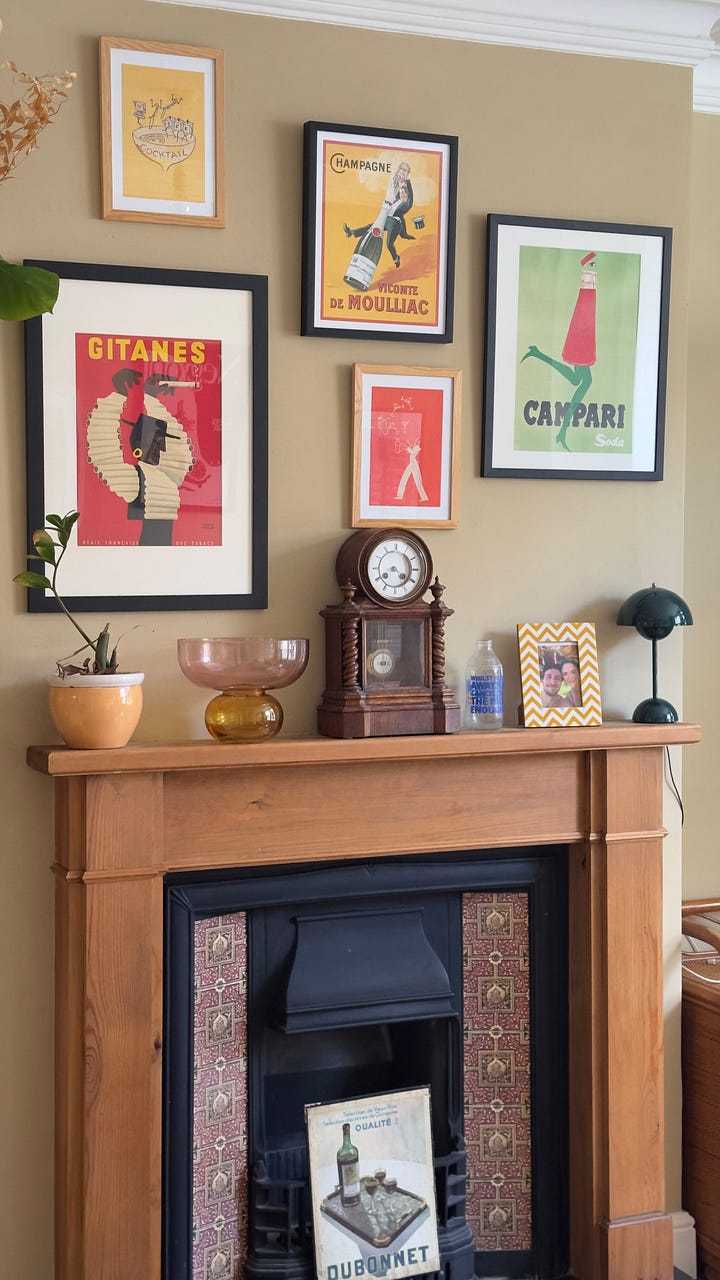
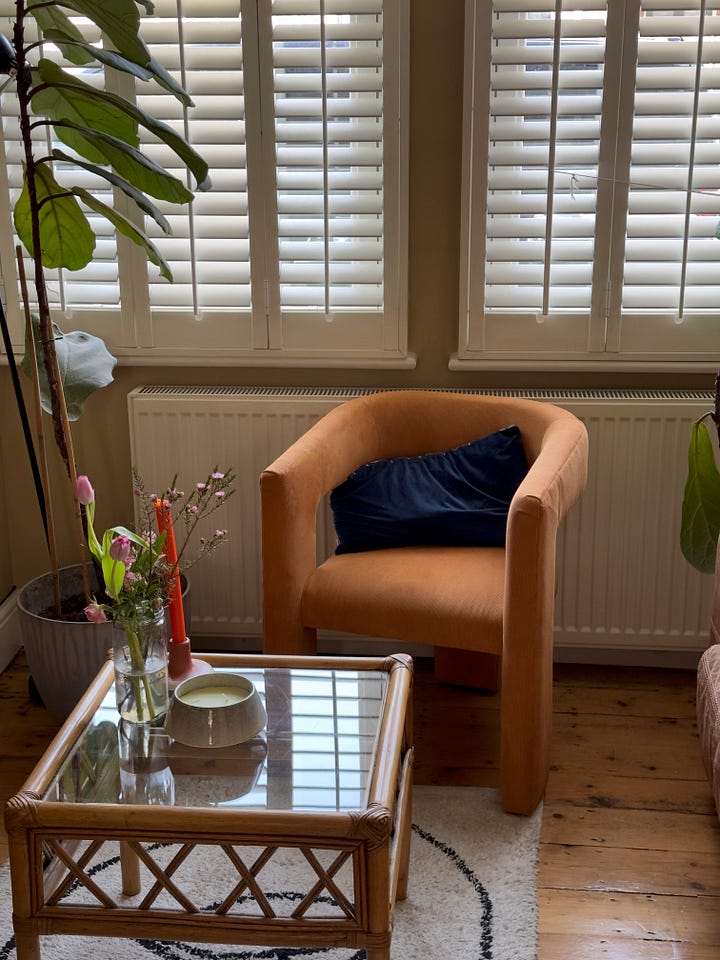
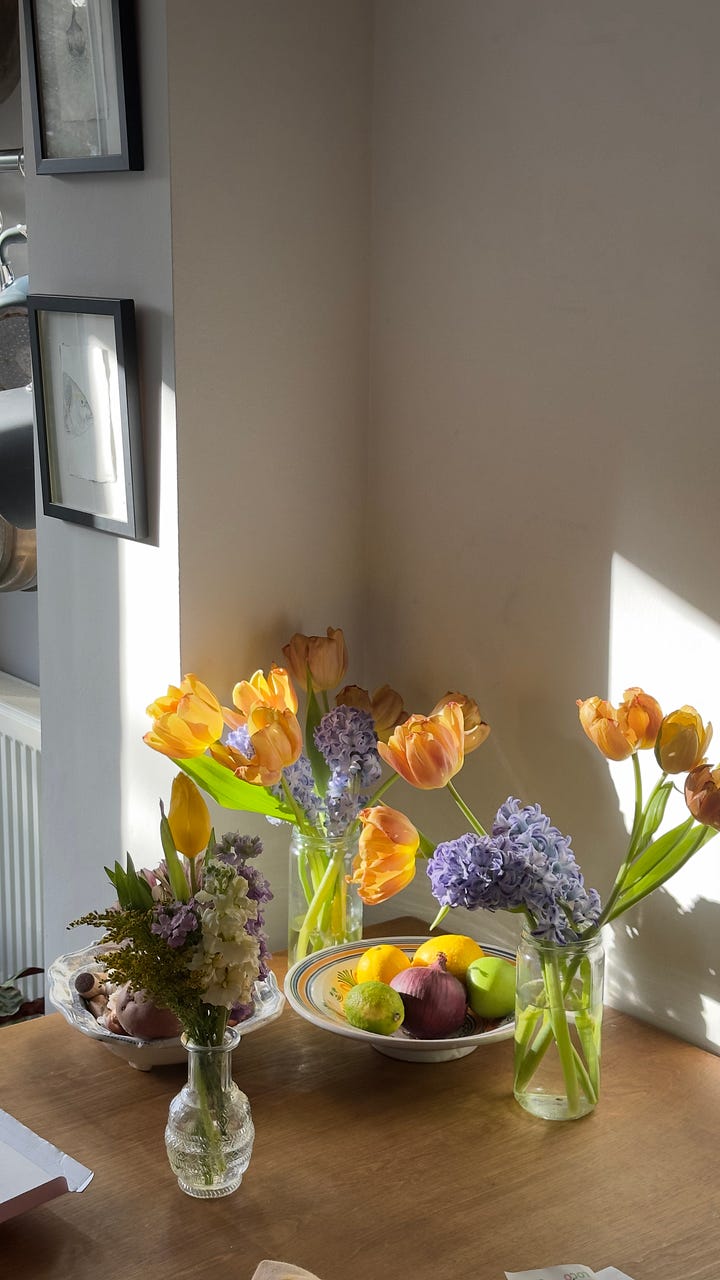

Cooking in my new kitchen has been very special. It obviously has its kinks of course, but on the whole it’s a joy. It has a lot more storage than my last space, where I had to keep various bits of kitchen kit outside in my car. Most importantly it gets a lot of light which both for photography and mental health purposes is proving to be utterly delightful.
For my very first Dinner Party menu in the new home, I wanted to share a dreamy little housewarming menu that functions on a few different levels. I think most often those first few guests are your family (certainly in our case), and the ultimate family meal is of course a roast dinner. Now, I am never going to be the girl you come to for a standard meat and two veg, gravy and yorkies roast. It’s just not my bag. But I love the conviviality and generosity of a roast, and that felt like a good thing to do when you want to fill a new home with laughter and love.
To kick off our housewarming menu we have Two Very Good Toasts to share with lots of welcome bevs, perhaps even standing up. The first is piled high with shredded courgette that has been tossed with lemon, dill, chilli and grated halloumi for a fresh, zingy and light snack. For the other, shallots are pan-roasted in butter, then topped with sliced pickled chilli and a grating of sharp cheddar. You could of course just do one toast, it would still be a lovely intro.
Then for our main we have a big old slow roast shoulder of pork, with excellent crackling to boot. British asparagus season is finally here and I am determined to make the most of it. Our spears are very simply pan fried in the juices from the roast pork and served with a punchy anchoïade sauce. Anchoïade is a provençale speciality made from blitzed anchovies, garlic, capers, acid and oil. Fatty meats like pork are perfect with strong, savoury condiments like this and honestly I just love having the option of making a sauce in the food processor in one fell swoop, rather than faffing around making gravy. You can’t have a roast without potatoes, but to stick with our mildly provençale theme I’ve cooked mine in a rich saffron stock. They are buttery, fragrant and oh so good with every single flavour on your plate. Plus they look divine.
To finish, I’ve recreated an old English dessert that I have wanted to do for a long time on this newsletter. Queen of Puddings is a weird recipe on paper, but oh my god is it just wonderful to eat. It’s got hot, caramelised meringue, hot raspberry jam and a soft, creamy custard/sponge hybrid on the bottom. It’s glorious. LET’S EAT!
TWO VERY GOOD TOASTS
It’s no secret that I bloody love a toast-based canapé and a roast, which can sometimes feel a bit overwhelming as a meal, is a great time to wheel them out. These are both super easy but incredibly tasty and each fits their own genre. Our courgette toasts are refreshing and bright, not too heavy on a tummy about to be filled with meat. Their shallot brothers are a bit richer, very moreish and excellent drinking food, if that’s what you are doing. Of course you could very easily just do one type, in which case you may wish to double the recipe for more bites per person.
FOR THE TOASTS
1 baguette, sliced into 12 thin slices
2 tbsps olive oil
1 clove of garlic
For the toasts - preheat the oven to 200 fan. Drizzle the olive oil onto the sliced bread on a large baking tray. Bake for 10 - 12 minutes until evenly golden and crisp on both sides. Once out of the oven, immediately rub all the bread with the garlic so that it takes on the flavour. Leave on some kitchen paper until needed.
COURGETTE AND HALLOUMI TOASTS
1 small courgette, coarsely grated
¼ tsp flakey sea salt
1 red chilli, deseeded and finely chopped
Zest of 1 lemon, juice of ½ a lemon
125g halloumi, coarsely grated
Zest and juice of 1 small lemon
2 tbsps extra virgin olive oil
A large handful of dill, finely chopped
Salt and pepper to taste
Pop the grated courgette into a bowl with salt, mix well and leave to stand for 15 minutes. Then put the courgette into a jay-cloth or clean tea-towel and squeeze it out very well to get rid of the excess water. Courgettes are high in moisture and it is good to do this so they stay crunchy on the toasts. Now mix your courgette with the chilli, lemon zest and juice, halloumi, olive oil and dill, and season to taste. Raw halloumi is delicious if you haven’t tried it! I love grating it over salads, sandwiches, soups etc. Pile the courgette mix onto the waiting toasts and serve immediately.
MAKE AHEAD -
The toasts can be baked up to 6 hours ahead and kept at room temperature. You may want to briefly reheat them (160 fan, 10 mins) before serving.
The courgette mix can be made up to 6 hours ahead, just leave the dill out until the very end.
SUBSTITUTIONS -
These would be just as good with crumbled feta or salted ricotta tossed through the mix.
I like dill here but mint, coriander or basil would also be lush.
SHALLOT, CHEDDAR AND CHILLI TOASTS
180g small, round shallots, peeled and halved
2 tbsps olive oil
75g butter
salt and pepper to taste
60g sharp, mature cheddar
80g pickled chillies, thinly sliced
To peel the shallots more easily, I soak them in a bowl of hot tap water for 15-20 minutes or so.
Heat the oil and half the butter in a small pan until sizzling on a medium heat. Pop the shallots in cut side down and fry for 4 minutes or so until a deep golden, then turn. Add the remaining butter and once it is foaming, turn the heat to low and keep cooking the shallots in the sizzling butter for 15 minutes or so, turning often. The butter will become nutty and toasted and the shallots will soften and caramelise. Season with salt and pepper. Top the toasts the with buttery, warm shallots, then grate over your cheddar and top with the sliced pickled chillies. Sensational!
MAKE AHEAD -
The toasts can be baked up to 6 hours ahead and kept at room temperature. You may want to briefly reheat them (160 fan, 10 mins) before serving.
The shallots can be pan roasted up to 3 days ahead and reheated in a pan before serving.
SUBSTITUTIONS -
If you can’t find small shallots, by all means use sliced banana shallot or even red onion instead and cook as above.
I love the heat and punch of the pickled chillies here, but if they aren’t your favourite thing then use finely chopped pickled gherkin instead.
SLOW ROAST PORK WITH ASPARAGUS AND ANCHOÏADE
It’s about time we had a big hunk of pork on this newsletter! Roasting pork can often feel just as daunting as beef I think, because the pressure of getting a perfect medium rare is replaced by the pressure of getting perfect crackling. I will be sharing my method for that with you today which requires a bit of planning but nothing too stressful - no hair dryers or hot oil in sight. Alongside our pork is our sensational anchoïade and simply prepared asparagus. A beautiful piece of meat like pork shoulder doesn’t need much else, and I really love how light and seasonally appropriate this roast feels. For those of you who are not anchovy fans, I have added some alternative sauce ideas in the substitutions.
For the Pork rub
2.5kg pork shoulder, rolled with the skin on - ask your butcher. If it hasn’t already been scored, get them to do it very lightly.
1.5 tbsps fine salt
1 tbsp caster sugar
1 tbsp fennel seeds
6 cloves of garlic
1 tbsp black peppercorns
1 tbsp coriander seeds
To roast
1 onion, thickly sliced
1 carrot, thickly sliced
2 sticks celery, thickly sliced
200ml white wine
2 tsps fine salt, for the crackling at the end
For the asparagus
600g British asparagus spears, woody ends trimmed
Juice of ½ a lemon
Salt and pepper to taste
For the anchoïade
1 clove of garlic, peeled
160g jar of anchovies, including
2 tbsps capers, drained
60ml olive oil
4 tbsp red wine vinegar
4 tbsps water
A handful of parsley, finely chopped
A GUIDE TO GOOD CRACKLING
In my opinion the secret to good crackling is time. If I want to get a crispy skin on any kind of meat, I will always try and dry it out for as long as possible first, and that has proved to be by far the best method I have found for crackling. I like to give my pork at least 2, ideally 3 days uncovered, skin side up, on a high shelf in a dry fridge. Buy your pork 3 days before you need it, unwrap it immediately and dry off the skin with a piece of paper towel before putting in the fridge- the longer it sits covered, the longer the skin has time to sweat and get soft. Avoiding moisture on the skin is key - I don’t put anything on it at all, including the marinade. I only add salt to it just before it goes under the grill for its crowning crackle. For good crackling, you will want the layer of skin to be scored lightly, to allow some of the fat to render off. Often your butcher will already have done this for you, and sometimes they can be a little careless. When scoring the skin it’s best practice to avoid going too deep and getting down through the fat to the flesh, as that’s where juices can rise up during cooking and dampen your skin. You will notice your crackling might end up more chewy in these places, rather than shatteringly crisp. If you can score yourself, do, but you will need a very sharp knife. The best thing is to go to the butcher and ask for a piece of unscored meat then firmly instruct them to lightly score it for you. Just a few scores is all you need.
Finally, when it comes to getting that pop, I typically adopt the reverse sear technique. I slow roast the meat uncovered (no sweating!!) and then when it’s ready, wrap the fleshy parts in foil, dry the skin, rub salt on it and pop the whole thing under a hot grill. The skin will blister and crackle and be similar to a pork scratching in texture with lots of little bubbles all over. It’s divine every time.
So, imagining you’ve bought your pork, got it home and it’s sitting uncovered in the fridge, you can also marinade it for a couple of days too - it won’t come to any harm. For our marinade blitz or pound all spices together first until they are a bit more finely ground, then add the salt, sugar and garlic and blitz again. Rub this all over the flesh (NOT THE SKIN), taking care to push the marinade into the middle of the pork where it has been rolled too. It can sit happily for 2 or 3 days with this marinade on, just be aware it will make your fridge smell a bit.
The pork takes 4.5 hours to cook, 20 or so to crackle, and then should rest for at least 30 minutes, so make sure you preheat your oven in plenty of time to get all of this done before you eat. Here are a couple of tables for your timings, I’ve included options for lunch and dinner. The later you are eating, the more time you will have with the oven in the morning to get other stuff cooked.
You can roast your pork and let it sit for a bit before you do the final crackle, if you want to whack some stuff in your oven in between (toasts perhaps).
Preheat your oven to 140 fan. Pop the onion, carrot, celery and wine into the bottom of a deep roasting tray. Put the pork shoulder on top of the veg, skin side up of course. Roast at 140 for 4.5 hours, then remove from the oven.
Put the pork onto a foiled tray to go under the grill. Drain the roasting juices and veg through a sieve into a large frying pan - there will be plenty of fat and beautifully savoury liqour, this will be what we cook our asparagus in. Discard the veg or serve it with the pork - it’s not much but it is tasty.
Pop the grill on to 225. Foil the meaty edges of the pork so they don’t burn, taking care to leave the skin uncovered. Rub the skin with the fine salt. Pop under the grill and don’t go anywhere, you may need to turn your pork to get an even crackle or cover any bits that are browning too quickly. Cook until the skin is bubbled and crisp - around 20 - 25 minutes, then remove from the oven to rest uncovered.
While the pork is roasting you can make the anchoïade. Simply blend all the ingredients together in a food processor apart from the parsley to make a thick, shiny sauce. Add more water if it is very thick, it should be a similar consistency to mayonnaise. Stir through the parsley and set aside until needed.
Cook the asparagus while the pork is resting. Put the trimmed spears in a large, flat frying pan with a lid and all the pork roasting juices. Pop the pan on a high heat with the lid on and bring to a boil. Cook for around 3 minutes covered, stirring to make sure the asparagus is cooking evenly in the juices. After 3 minutes remove the lid, cook for a further minute or so to reduce the juices a bit, then remove from the heat. Season with lemon juice, salt and pepper.
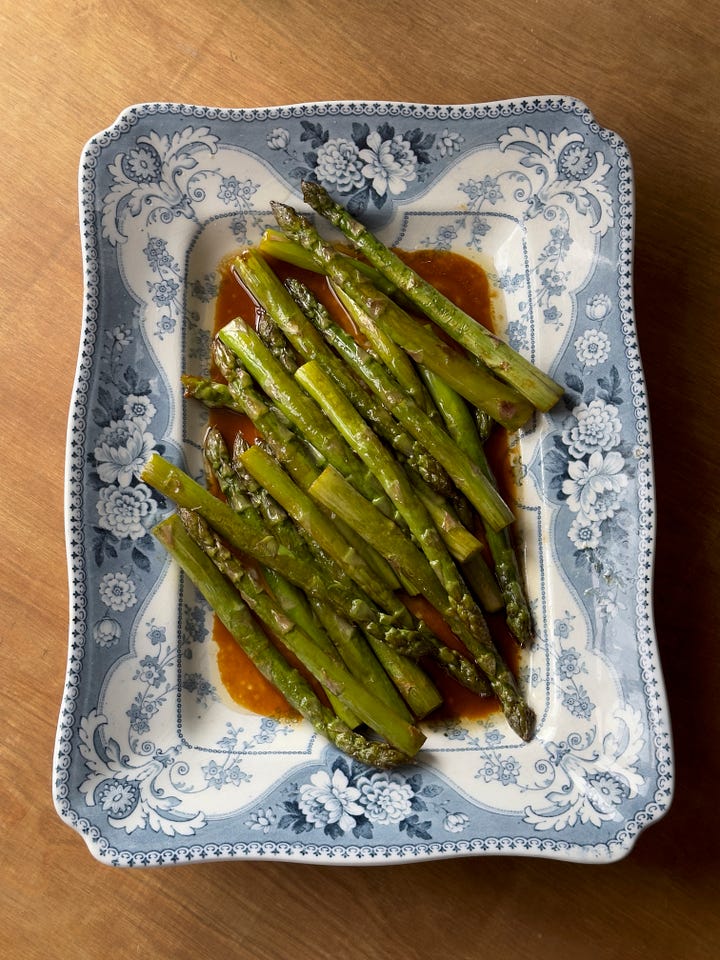
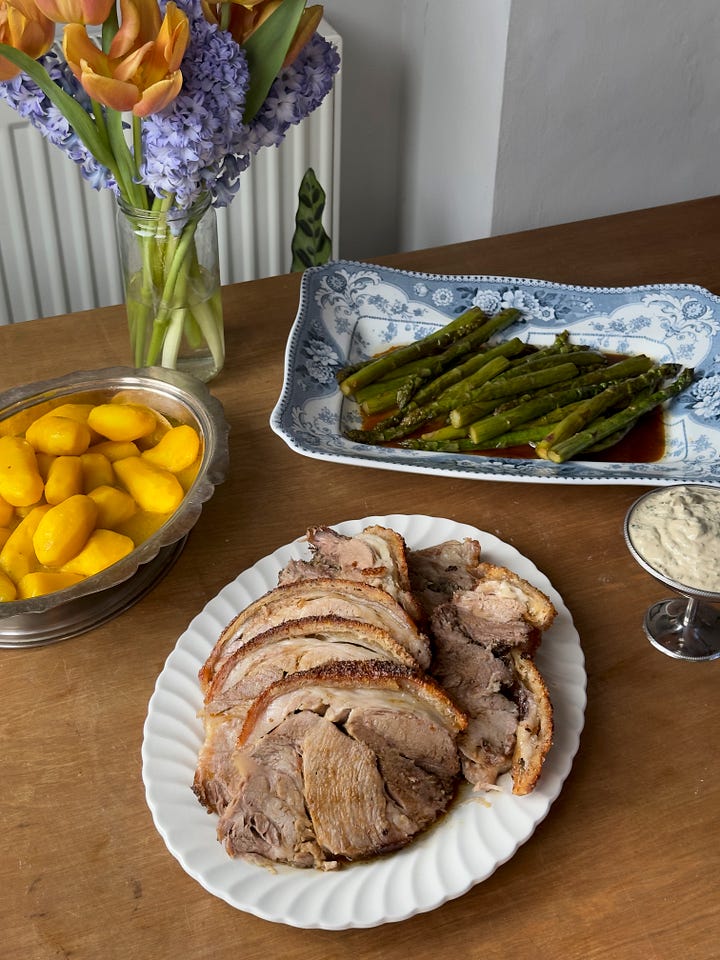
When the pork has rested, slice with a bread knife into thick slices and serve with the asparagus, anchoïade and saffron potatoes (recipe below).
MAKE AHEAD -
You can roast the pork and let it sit for up to 1 hour before putting it under the grill to crackle and don’t need to rest again after that, if you prefer.
The anchoïade can be made up to 2 days ahead.
SUBSTITUTIONS -
If you don’t like anchovies then here are some other good sauce options
Swap asparagus for tenderstem broccoli or spring greens, or do a combination of all three.
SAFFRON POTATOES
I love cooking with saffron, it is a glorious spice that is wonderfully savoury and decadent. The idea for these potatoes came from a train of thought I had when researching anchoïade. It made me think of another stunning French recipe, Bouillabaisse, and the delicious saffron, broth-soaked potatoes that sit in the soup alongside all the stunning seafood. I wanted to recreate that but as a side in itself, for with both meat, fish or veg, and this is where I landed. This recipe is perfect for all the beautiful spring potato varieties that are coming into season - Ratte, Jersey Royal, Charlotte.
1 kg new potatoes, peeled (best way for the saffron to soak in) - I used Ratte
1g saffron
2 chicken or vegetable stock pots/cubes
Salt
80g butter
Boil a kettle. In a pestle and mortar, crush the saffron to a fine dust. Then pour a couple of tablespoons of your boiled water into the saffron and stir well. Leave to stand for a couple of minutes - this is the best way to get the most out of your saffron as the crushed spice releases much more colour and flavour. Meanwhile take 200ml of your freshly boiled water and use it to dissolve your stock pots or cubes, stirring well with a whisk. Potatoes should always start cooking in cold water, but we need to make sure the stock is dissolved before we use it or it won’t permeate the liquid well. Pour the prepared stock along with the saffron water into a saucepan. Add in the potatoes and enough cold water to cover - around 1.5l but no need to be exact. Season with a pinch of salt and pop onto a high heat. Bring to the boil, then simmer the potatoes for around 10 minutes in the stock, before turning the heat off and letting them sit in the stock for a further 20 minutes. They will finish cooking and soak up all that beautiful liquid. Drain the potatoes, reserving about 100ml of the saffron liquid. Pop that into a pan along with the butter and potatoes. To serve, heat the potatoes, saffron stock and butter together in a pan covered with a lid on a medium heat, so the butter melts into the stock and coats the potatoes.
MAKE AHEAD -
You can boil the potatoes, drain them and let them sit up to 24 hours ahead. Simply reheat for slightly longer as above, with the butter and a bit more stock.
SUBSTITUTIONS -
You can do this with just water if you don’t have stock
It’s also nice to mix through a grated clove of garlic when finishing the potatoes in the butter, if your other dishes aren’t already really garlicky.
QUEEN OF PUDDINGS
I first tried this dish as a child and thought to myself “what is this sorcery!!” It’s one of those dishes that is equally bizarre as it is wonderful. The base is a baked custard, thickened with bread crumbs so that it has an almost spongey texture, topped with a layer of raspberry jam and then with a layer of floofy meringue. It is then baked again to brown and set the meringue. It’s certainly a dessert on the sweeter side, but my god is it good. I have a real weakness for hot jam. Meringue is not something that can be made in advance easily, however you have 2 options here. You can make the whole pudding a few hours before your guests arrive and reheat it when you need it, or you can make the custard layer and then while your quests are finishing up, make the meringue and then top it and bake it to order. It is absolutely show-stopping doused in double cream.
You will need 5 eggs, separated for this recipe - yolks for the custard, whites for the meringues.
For the custard
700ml whole milk
100ml double cream
150g fresh white breadcrumbs
40g unsalted butter
Zest of 1 lemon
1 tsp vanilla bean paste
50g caster sugar
5 egg yolks, beaten
Pinch of salt
For the jam layer
200g raspberry jam
Juice of 1 lemon
For the meringue
250g caster sugar
5 egg whites
1 x 30cm/23cm baking dish, greased with 2 tsps butter
Double cream, to serve
Start by making the custard layer. Preheat the oven to 160 fan. Heat the milk, cream, sugar, lemon zest, vanilla bean paste and salt in a saucepan on a medium heat until until just steaming. Stir in the breadcrumbs and butter off the heat, then leave to stand for 5 minutes. Then pour in the beaten egg yolks and stir until well combined. Pour the mix into the tin, then bake in the preheated oven for 20 minutes. The custard should still have a little wobble to it. Set aside until needed.
When you are about to make the meringue and bake, warm the jam and lemon juice together in a pan until a bit more liquid, then spread it all over the custard layer. Preheat the oven to 160 if it is not already at that temperature.
To make the meringue, pop the egg whites into the clean and dry bowl of a stand mixer, or into a large bowl. Whip them on a medium speed either with your mixer or electric beaters until they reach soft peaks. Then, while still on a medium speed, start adding in tablespoons of sugar at a time, waiting for about 15 - 20 seconds in between each addition. Continue doing this until all the sugar has been used up - your meringue should be thicky, glossy and airy. Turn the speed up to high and mix for another 5 minutes and then turn it off. You can either put your meringue into a piping bag and pipe on top (I did this with a xx nozzle), or you can just use a spoon. Top the jam layer with the meringue, making sure whichever way you choose you have lots of lovely texture on the top.
Bake in the preheated oven for 25 minutes, then switch to grill at 220. Grill for a further 3 minutes or so until the meringue is lovely and golden brown - don’t walk away as it burns easily!! Serve with plenty of double cream.
MAKE AHEAD -
You can bake the whole pudding up to 6 hours ahead and leave at room temperature. Reheat for 15 minutes at 160 fan uncovered.
Or make the custard base up to 24 hours before and keep in the fridge until needed. Bring to room temperature before finishing and baking with the jam and meringue.
SUBSTITUTIONS -
Use any jam flavour you like! Or even make your own. Plum, strawberry or blackberry would be lush.
TIMEPLAN
This first plan should help you see what you can get done in advance, so that for each course on the day you have at least 1, maybe 2 major parts of it taken care of. I appreciate that not everyone’s weeks are easily peppered with dinner party prep, but if you’re hosting after work or on a day where you can’t be in the kitchen, getting ahead is going to save your arse.
MISE-EN-PLACE
This is the fancy name we give to the food prep each section in the restaurant needs to do for their dishes. Hopefully breaking down each dish like this will help you feel organised.
Use the hour before your guests arrive to organise your space too- I find it helpful to group ingredients by dish so it is all in the same place. Little ramekins are really useful for this.
STYLING
I think this menu is fairly rustic in many ways, it reminds me of something you might find in a French country kitchen, and so that’s what I went for in terms of styling. I was kindly given lots of beautiful seasonal flowers when we moved. Blousy orange tulips and frothy, fragrant hyacinths which actually worked wonderfully together, the colour contrast and pale green leaves and stems brightened my kitchen up no end, without feeling stuffy or contrived.
The previous owners left a small wooden table in the kitchen and I really like shooting on it, so I abandoned my usual white tablecloth in favour of the rich wood. If you have a lovely wooden surface, sometimes it’s worth letting it sing.
For the food, I served the toasts on a couple of simple vintage plates with borders rather than background designs. The toasts themselves have a lot going on detail wise, so it was nice to let them shine on slightly plainer, off white plates. For our roast I gave the asparagus a dramatic blue platter, which paired with the simple plating of the veg made for a striking effect. Blue and green are always great together. The pork was sliced and piled onto my favourite plain white oval dish, but you could just as well serve it on a board, carving à table. I chose metal dishes for our anchoïade and potatoes, because the silver really sings on the wood, and also gives the colours of the food a real chance to shine too.
Finally our pudding can be done in any baking dish you have, but I do like my enamel babe for this, with the blue rim really singing against the bright red jam.





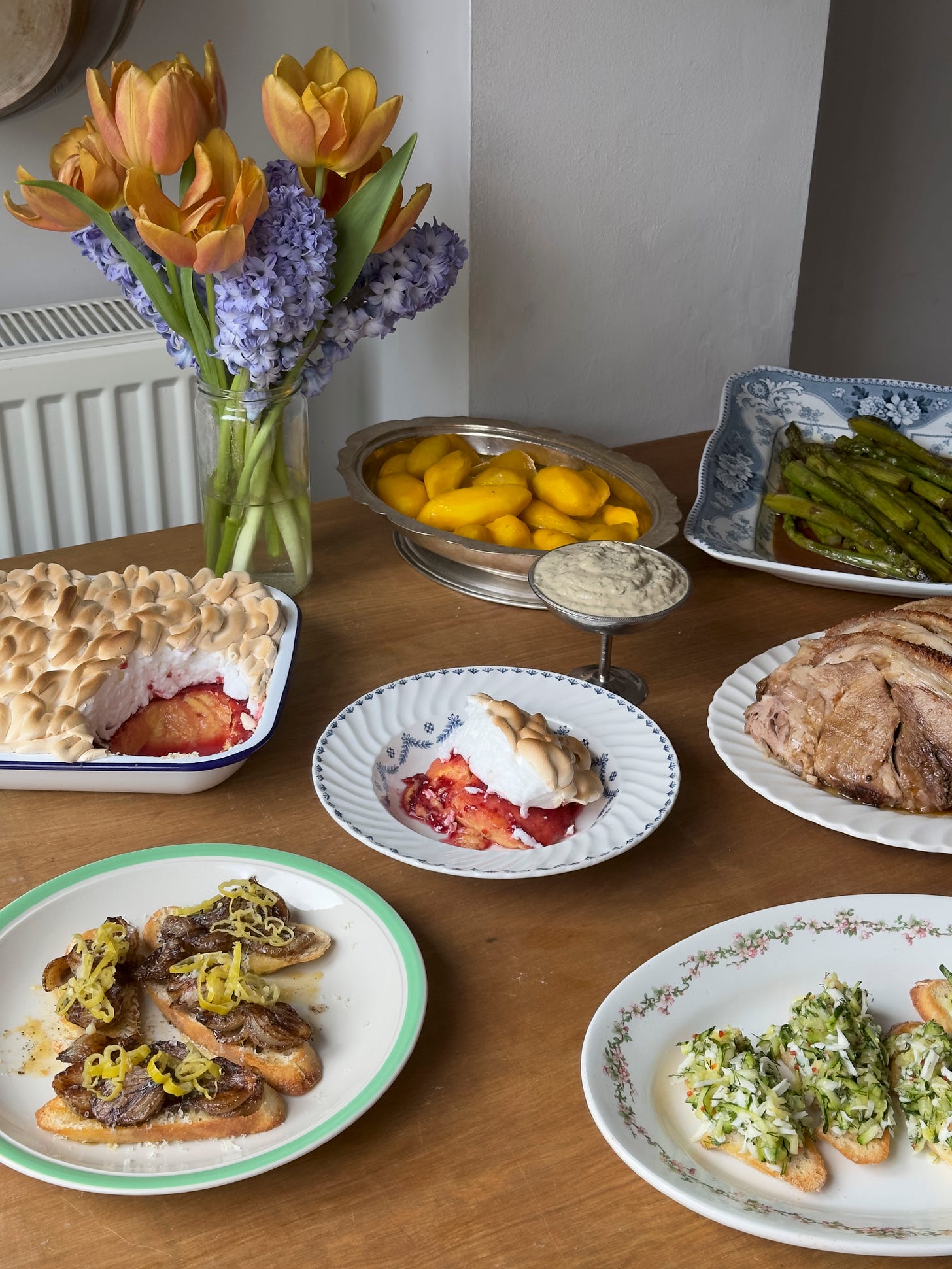
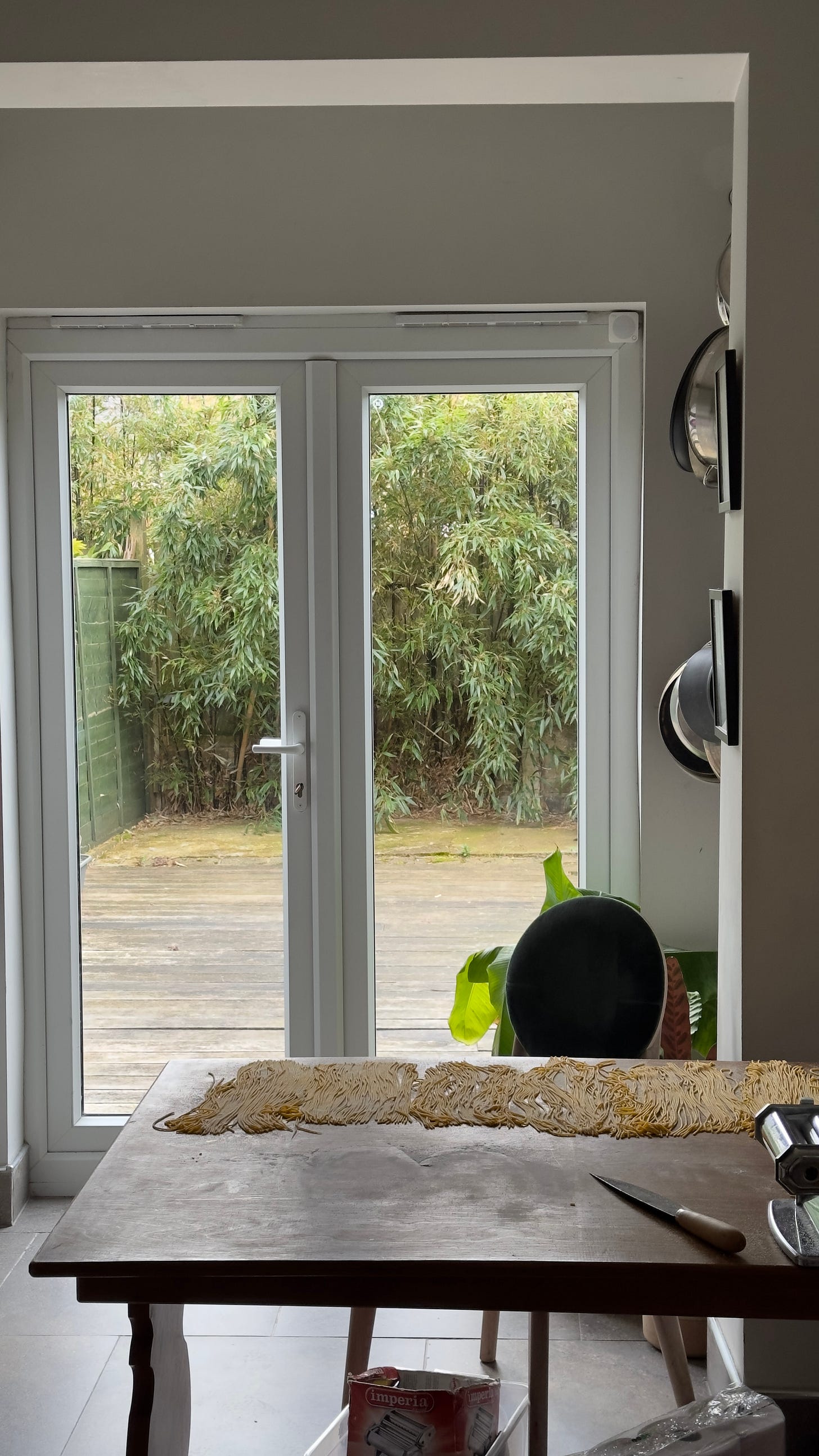
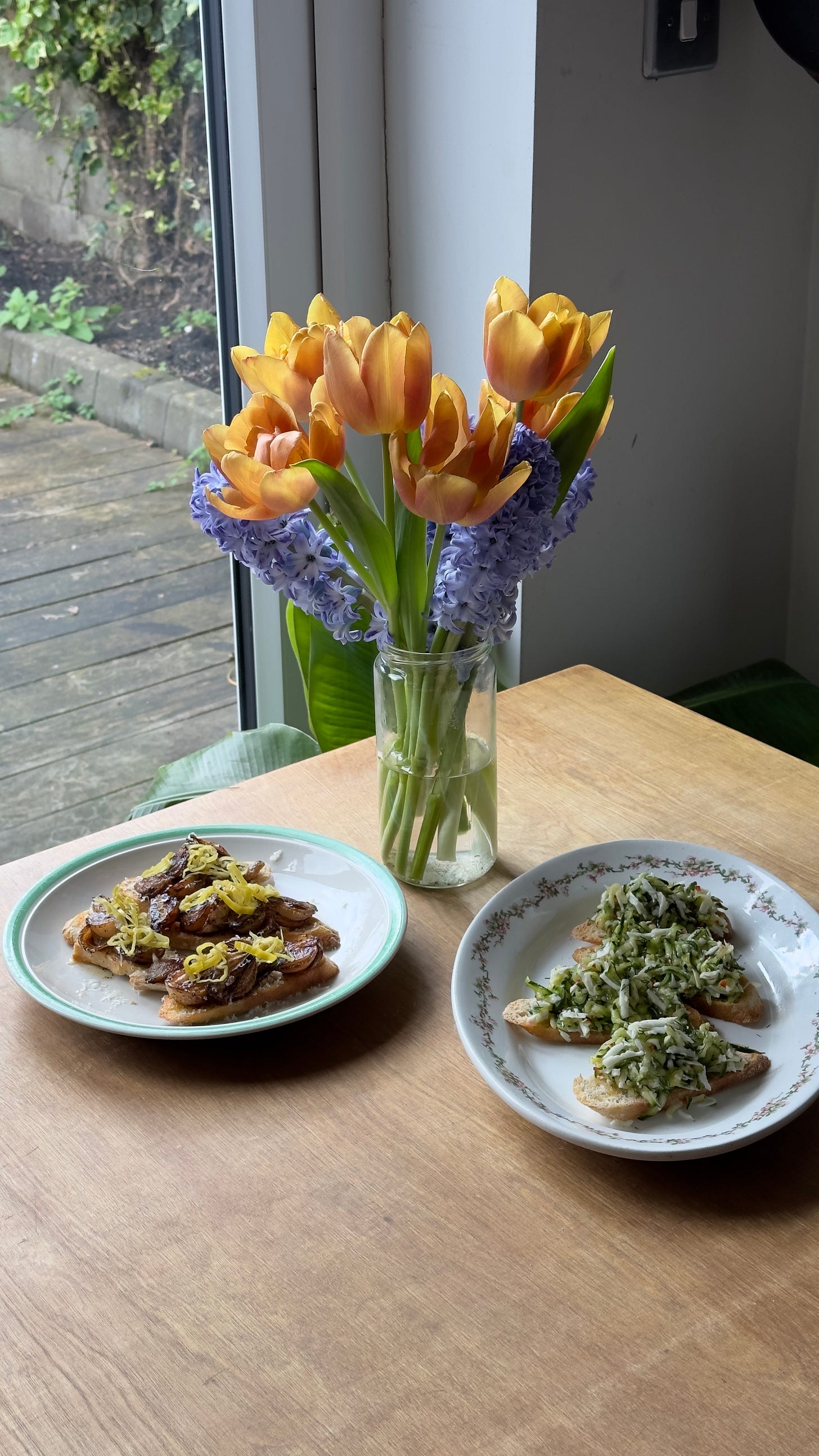
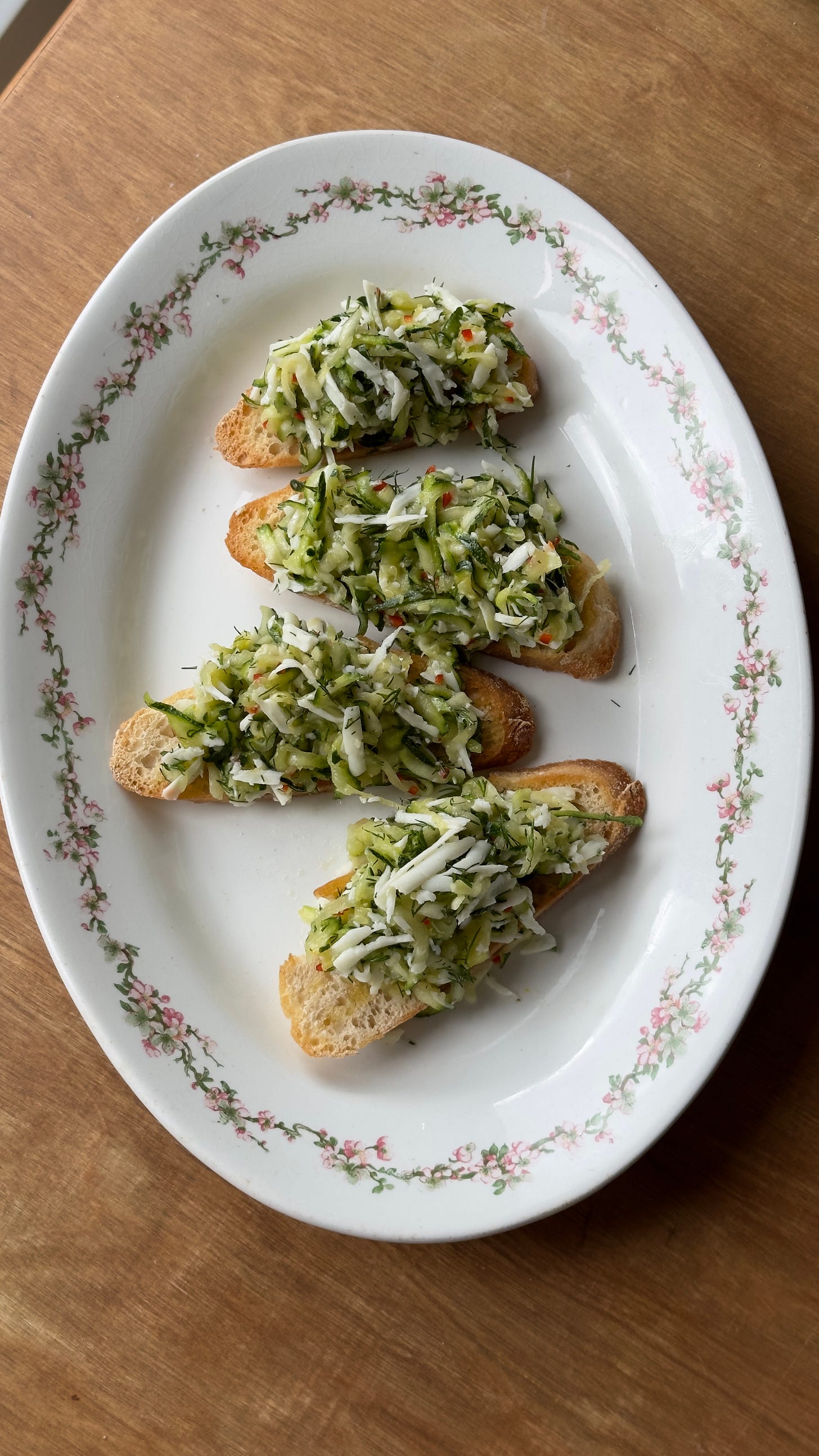

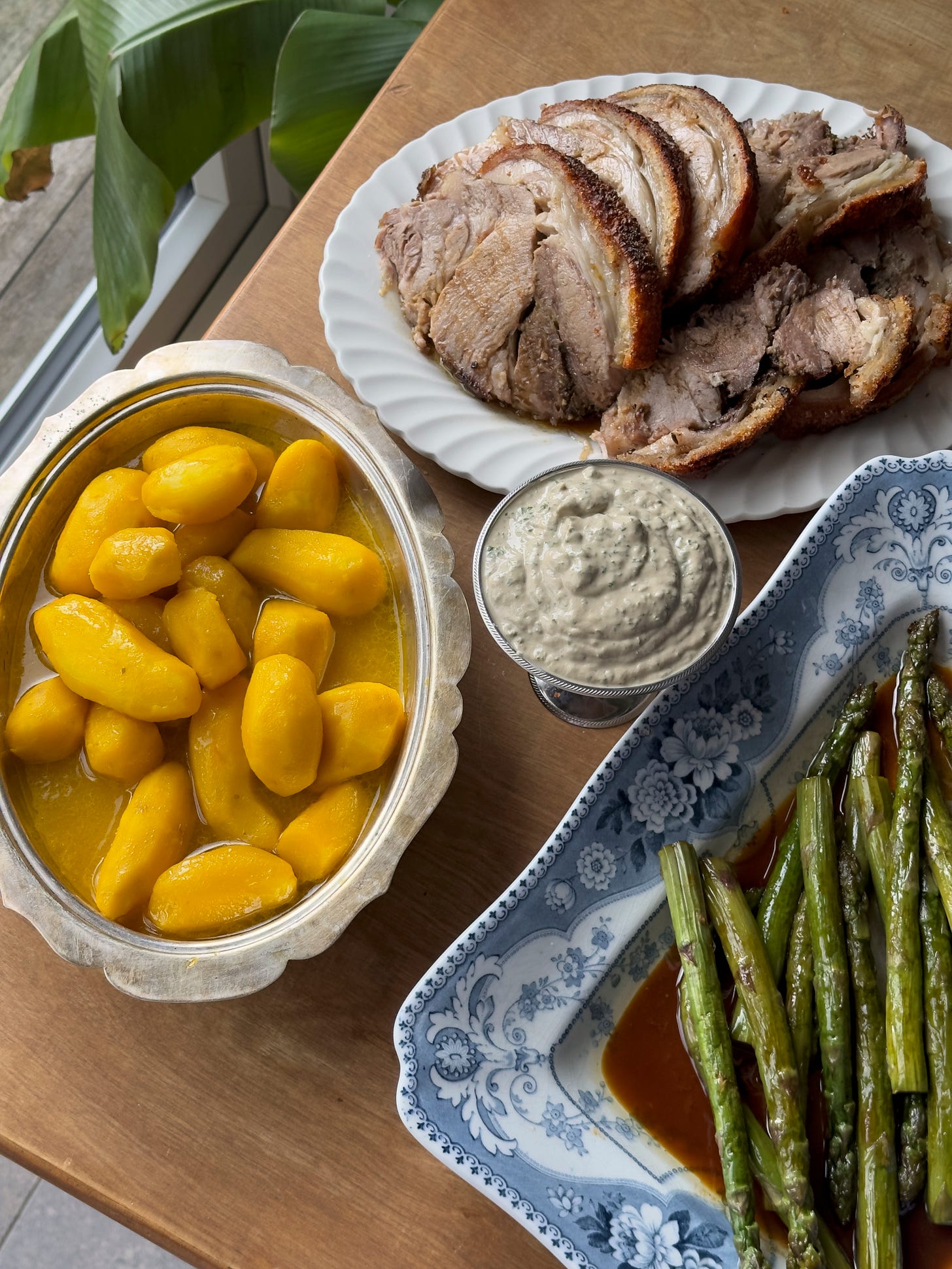



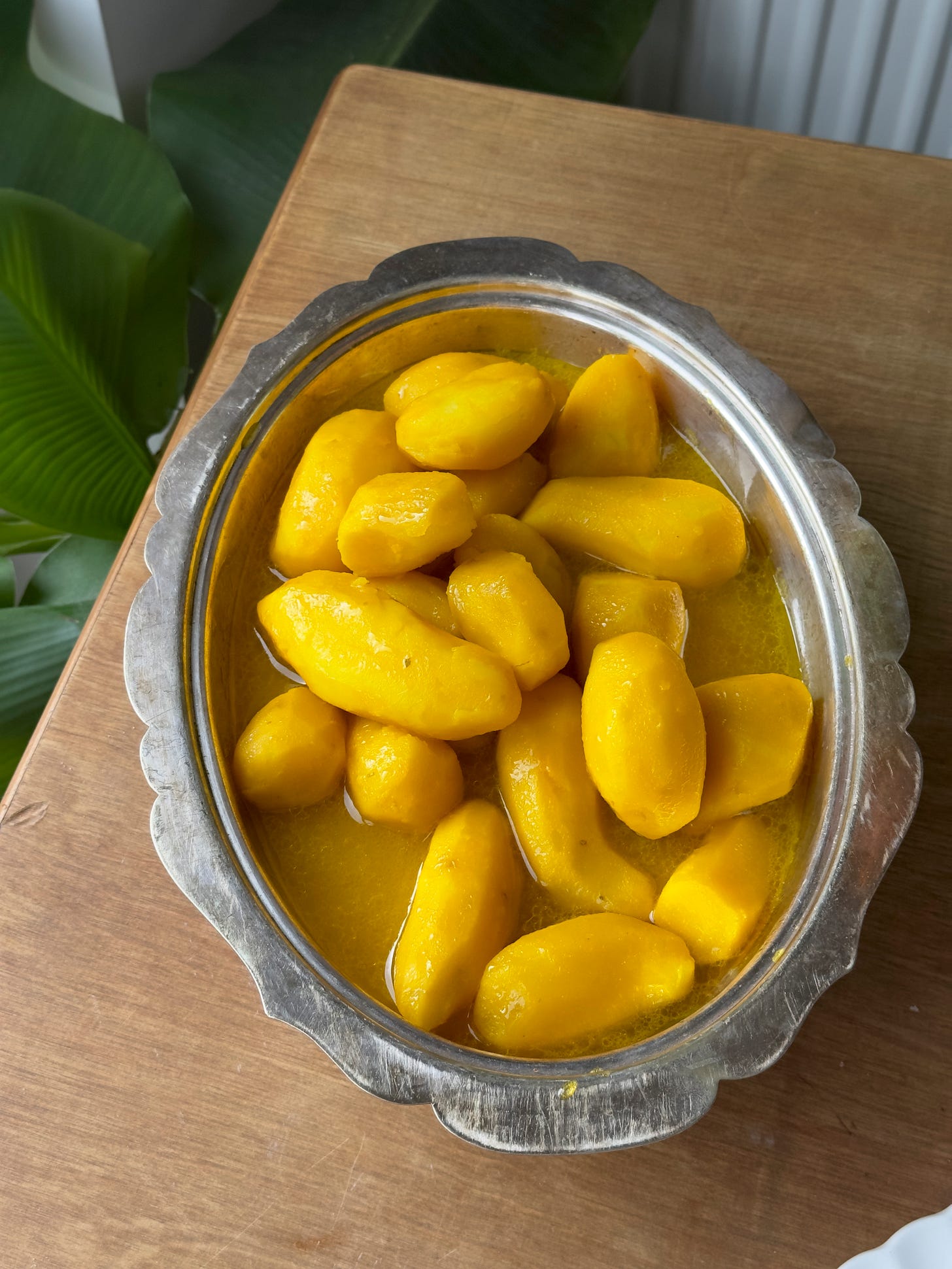


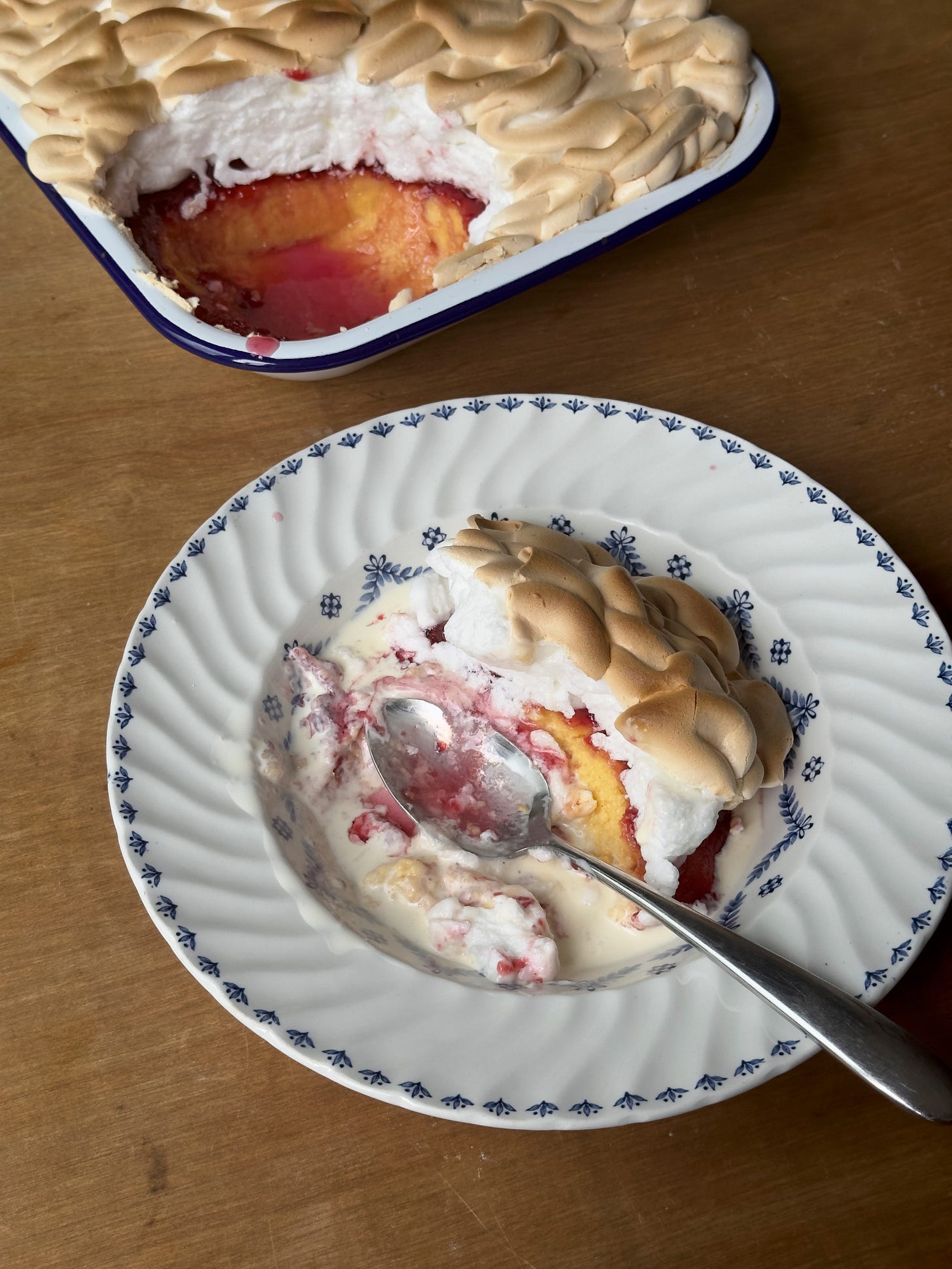
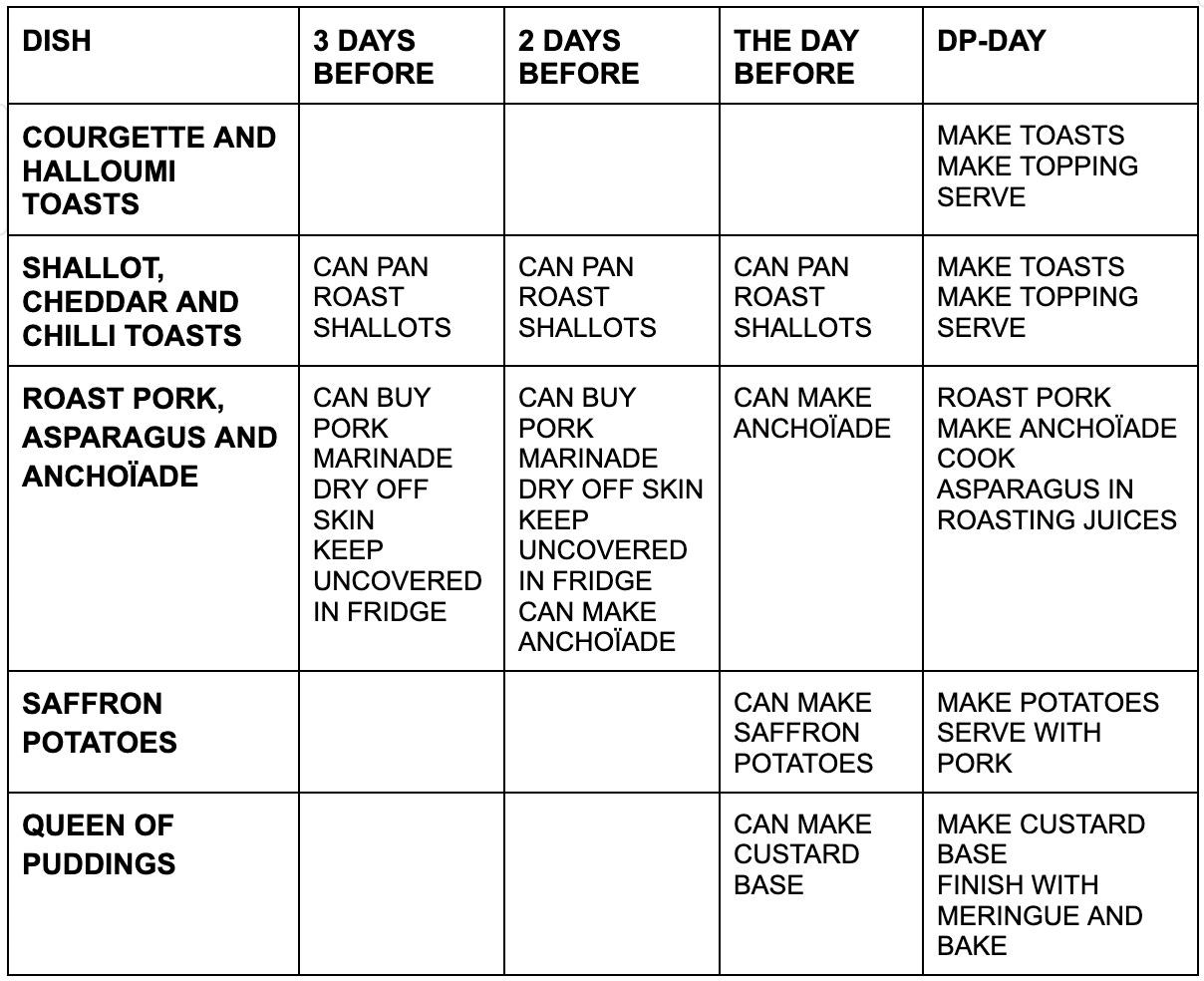

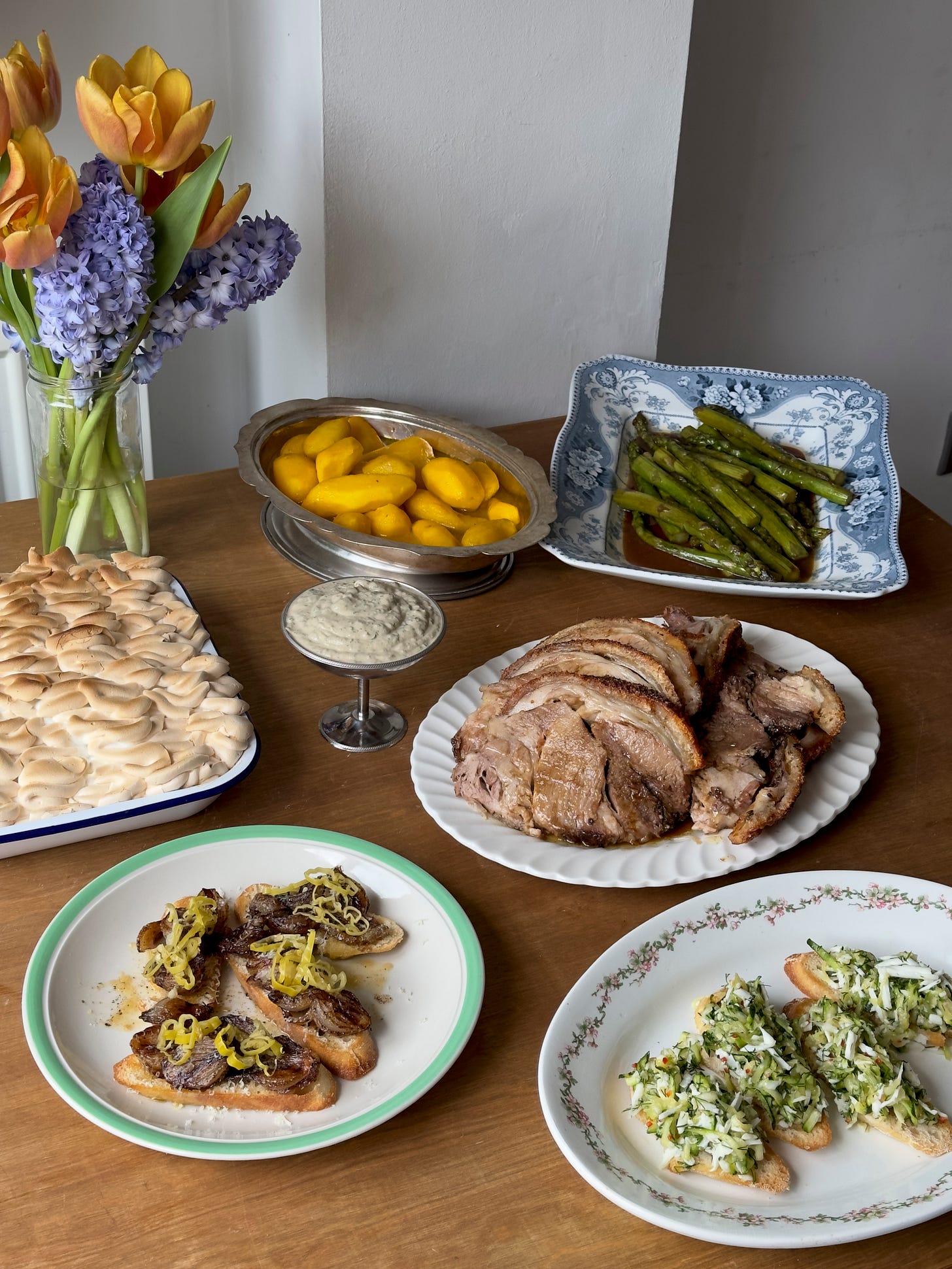
the toasts look so good!
I just made the pork... INCREDIBLE! The rub... The sauce... Everything was stunning. Absolutely making this for everyone who comes for dinner from now on. 💖